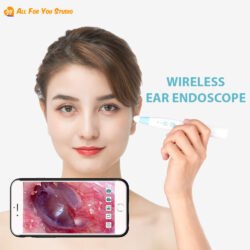
You might think that seeing inside an ear is not that straightforward, and it usually isn’t. However, with modern advancements in medicine and a bit of education, it is more accessible than ever. Whether you’ve had chronic ear issues or are simply keen on your ear health, knowing how to safely scope out your ear is essential. In this blog, discover multiple methods and instruments available for seeing inside your ear, the significance of ear health, and when it is recommended to consult medical professionals. But first, let’s take a quick look at how important ear health is.
The Importance of Ear Health
You may already know that the ears are essential for hearing, but it helps to understand more about what they do. The ears are not just responsible for hearing; they also contribute to your body’s balance system. Some of the common issues to affect the ears are infections, wax impaction, or tinnitus. All of these can be avoided with regular monitoring and proper care. Therefore, it is crucial to be aware of your ear health in general and have a look at what’s going on inside them every so often.

Traditional Methods for Seeing Inside the Ear
Otoscope
An otoscope is a standard instrument that all medical professionals use to have a close look inside the ear. This device produces light and includes a magnifying lens that helps to inspect the er canal and eardrum more thoroughly.
How it works: The medical professional places the device in the client’s ear canal to view the eardrum and the canal.
Pros: Highly effective. Produces high-quality images.
Cons. It requires a professional approach and expertise.
Ear Speculum
An ear speculum is another standard device that, when used in combination with a light source, allows for a quick and simple examination of the ear canal.
How it works: The ear speculum is inserted into the ear canal, and the light source is shone inside to illuminate the canal.
Pros: Easy to use. Fast examination.
Cons: Less visible than an otoscope. Can be unpleasant if not used properly.
Digital otoscopes
Digital otoscopes are simply modern versions of traditional otoscopes fitted with cameras that display images on a screen.
A camera is attached to the otoscope, and images and videos of the ear canal are captured digitally. Some digital otoscopes can save data for later review while others connect to smartphones or computers to provide easy viewing and sharing.
Advantages of a digital otoscope include high-resolution images and videos, which can be saved in a secure location, and allow for easy viewing.
They are, however, expensive compared to traditional otoscopes and require the user to have some technical knowledge to operate.
Smartphone otoscope
Smartphone otoscope attachments are also popular in modern times.
They attach to the user’s smartphone, utilizing their camera scroll and without the onboard application that provides a view of the ear canal.
These devices are mostly used at home for primary checkout. Advantages include easy use at home and sharing of images with healthcare providers.
However, the quality depends on the smartphone camera or the extension used. Endoscope cameras are devices manufactured for medical and industrial use but can also be employed in examining ears.
They come with a small monitor or screen on which to display images and have LED lights for proper visibility.
Such a monitor or screen can easily be connected to the image vendor equipment to monitor image quality as the camera navigates the canal.
Flexible handling makes them easy to use, but extreme care is also necessary to prevent discomfort to users.
Use adequate lighting
Make sure that the place is well-lit to have a proper view.
Be gentle
Insert a device slowly and gently to prevent the ear canal or eardrum damage.
Do not do it if you are not confident.
Ask someone to assist you if you feel unsure.
Nevertheless, some issues cannot be resolved at home.
Professional guidance
Always seek professional guidance in the following cases:
- persistent pain that lasts for more than one day.
- hearing loss or pain in the ear; a discharge from the ear canal or the ear itself.
- foreign object established in the ear.
In addition to knowing how to see inside the ear, maintaining the ear health is vital.
Some of the key measures are: regular cleaning without the insertion of any objects into the ear canal as well as protect the ear from loud noises, in case of insertion of any other object, avoid sharp as well as stay hydrated to have a proper throw-away of earwax.
Conclusion
In conclusion, it is crucial to understand that it is simpler to see inside the ear in the modern world due to advances in technology, providing access to smartphone devices that attach to an otoscope. It is crucial to use such devices carefully to monitor the health of your ear.
Examples of vital signs are guided that show the wellness of a person from the inside.
A person can detect the problem early and alleviate it in the development stage if they are aware of the changes and follow proper procedures to eliminate the issues.
![Grand Sale Windows and MS Office -20% with code: MS20 [BUY NOW] Grand Sale Windows and MS Office -20% with code: MS20 [BUY NOW]](https://affiliate.kinguin.net/accounts/default1/m0x0b41/cc03a3b3.jpg)

